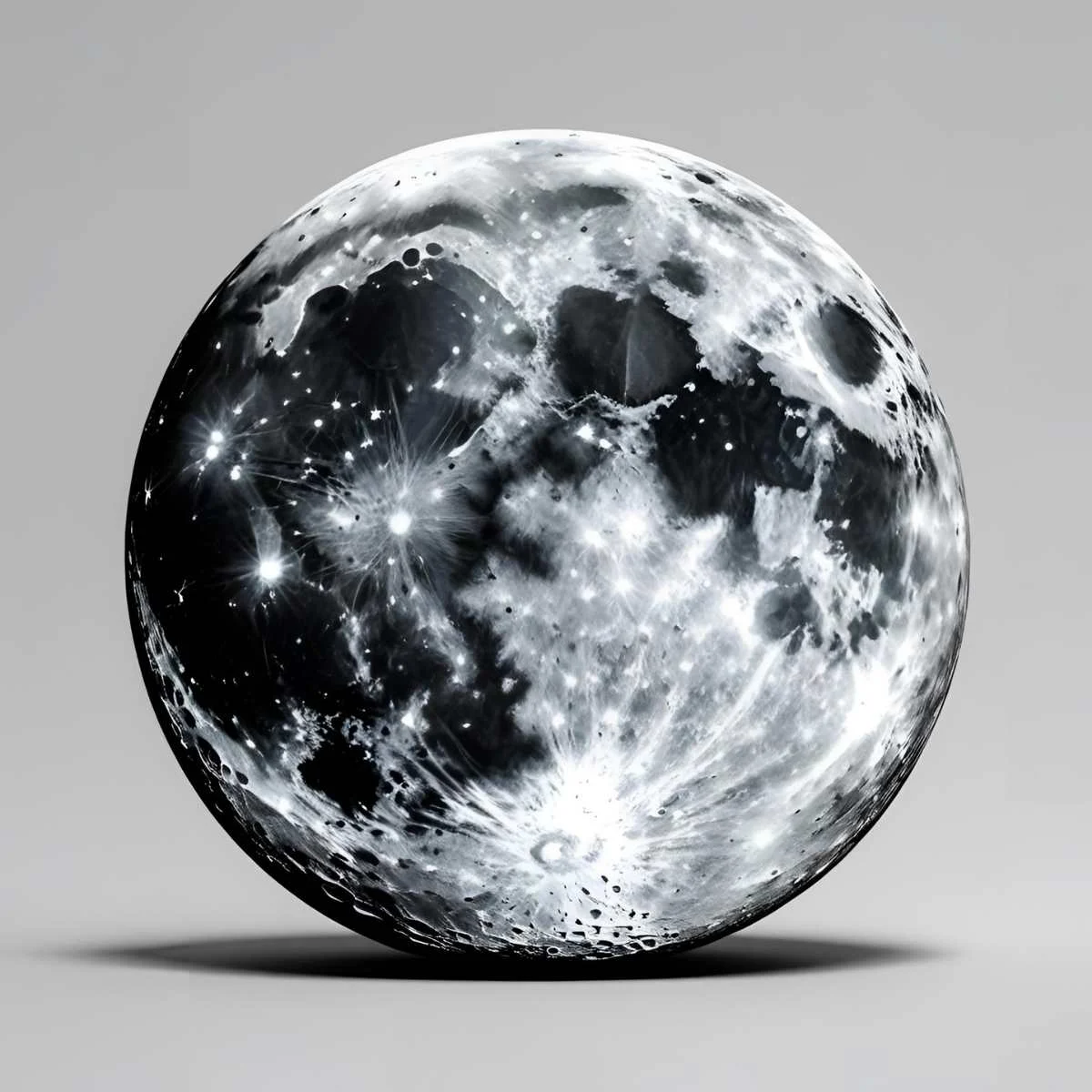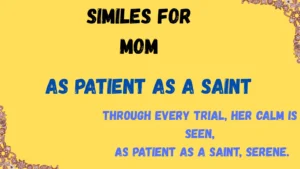The Lunar Charm of Similes ✨
Similes are like stars in a writer’s sky, using “like” or “as” to weave vivid comparisons that light up language.
They transform simple descriptions into poetic or relatable images, turning “The moon was bright” into “The moon glowed like a lantern, guiding dreams through the night.” For the moon—Earth’s celestial muse—similes capture its mystery, beauty, and influence, making it a perfect subject for creative expression.
Whether in poetry, storytelling, or casual chats, these comparisons make the moon feel closer. Ever wondered how a simile could make the moon shine brighter in your words? Let’s explore 25 unique similes for the moon, grouped by theme, to inspire your imagination! 🌌
Similes for the Moon: 25 Celestial Comparisons
These 25 similes paint the moon in diverse lights—its glow, phases, cultural significance, and emotional pull. Organized into thematic categories, each simile includes a meaning, a contextual example, and a specific application for writing, speaking, or reflecting. Let’s soar into the lunar landscape!
The Moon’s Radiant Glow 🌕
Similes for the moon’s luminous beauty and light.
- The moon glows like a lantern, guiding night’s wanderers.
Meaning: The moon’s soft light leads like a lantern in darkness.
Example: In a poem, “The moon glowed like a lantern, guiding her steps through the forest.”
Application: Use in nature poetry or a bedtime story to evoke calm, e.g., “The moon, my lantern, lit my path home.” - The moon shines like a pearl, gleaming in the night’s velvet.
Meaning: The moon’s smooth, iridescent glow resembles a pearl’s luster.
Example: In a romance novel, “Her eyes met his under a moon shining like a pearl.”
Application: Perfect for romantic scenes or a love letter describing a moonlit moment. - The moon sparkles like a coin, tossed into the sky’s treasury.
Meaning: The moon’s bright, metallic shine is like a coin in the heavens.
Example: In a children’s story, “The moon sparkled like a coin, tempting the stars to play.”
Application: Use in whimsical tales or a social media caption about a starry night. - The moon beams like a lighthouse, steering dreams to shore.
Meaning: The moon’s light guides imagination, like a lighthouse aids ships.
Example: In a reflective essay, “The moon beamed like a lighthouse, calling my thoughts home.”
Application: Great for introspective writing or a journal entry about inspiration. - The moon glimmers like a candle, flickering in the night’s embrace.
Meaning: The moon’s gentle light dances softly, like a candle’s flame.
Example: In a cozy scene, “The moon glimmered like a candle, warming their campfire talk.”
Application: Use in cozy narratives or a tweet about a peaceful evening.
The Moon’s Mystical Phases 🌒
Similes for the moon’s changing shapes and cycles.
- The moon wanes like a storyteller, fading into silence.
Meaning: The moon’s shrinking phase is like a storyteller pausing a tale.
Example: In a fantasy novel, “The moon waned like a storyteller, hiding secrets in shadow.”
Application: Use in mystical stories or a blog about lunar cycles. - The moon curves like a sickle, harvesting night’s dreams.
Meaning: The crescent moon’s shape reaps imagination, like a sickle cuts crops.
Example: In a poem, “The moon curved like a sickle, gathering my hopes.”
Application: Perfect for poetic reflections or a caption for a crescent moon photo. - The moon swells like a tide, pulling hearts to fullness.
Meaning: The waxing moon grows like ocean tides, stirring emotions.
Example: In a love story, “Her feelings swelled like the moon, full and unstoppable.”
Application: Use in emotional narratives or a diary entry about growth. - The moon shifts like a chameleon, changing its nightly mask.
Meaning: The moon’s phases transform its appearance, like a chameleon’s colors.
Example: In a science blog, “The moon shifts like a chameleon, surprising us each night.”
Application: Great for educational posts or a speech about change. - The moon fades like a whisper, slipping into dawn’s hush.
Meaning: The waning moon softens quietly, like a whisper fading out.
Example: In a morning scene, “The moon faded like a whisper, giving way to sunrise.”
Application: Use in dawn-inspired poetry or a journal about transitions.
The Moon’s Emotional Pull ❤️
Similes for the moon’s influence on feelings and dreams.
- The moon is a mirror, reflecting the heart’s quiet longing.
Meaning: The moon echoes inner emotions, like a mirror shows a reflection.
Example: In a memoir, “The moon, a mirror, reflected her loneliness under the stars.”
Application: Use in personal essays or a love letter to express deep feelings. - The moon sings like a lullaby, soothing restless souls.
Meaning: The moon’s presence calms, like a lullaby eases sleep.
Example: In a bedtime story, “The moon sang like a lullaby, tucking the world in.”
Application: Perfect for children’s books or a soothing Instagram caption. - The moon is a confidant, holding secrets under its glow.
Meaning: The moon listens to private thoughts, like a trusted friend.
Example: In a diary entry, “The moon, my confidant, heard my midnight wishes.”
Application: Use in reflective writing or a text about late-night thoughts. - The moon dances like a dreamer, twirling through the night.
Meaning: The moon’s movement inspires whimsy, like a dreamer’s dance.
Example: In a dance scene, “She moved under a moon dancing like a dreamer.”
Application: Great for artistic stories or a post about a moonlit event. - The moon is a poet, weaving verses in silver light.
Meaning: The moon inspires creativity, like a poet crafts words.
Example: In a creative writing class, “The moon, a poet, inspired her haiku.”
Application: Use in poetry prompts or a speech about inspiration.
The Moon in Cosmic Contexts 🌠
Similes for the moon’s role in the universe or science.
- The moon orbits like a satellite, tethered to Earth’s heart.
Meaning: The moon circles faithfully, like a satellite around a planet.
Example: In a science essay, “The moon orbits like a satellite, guarding Earth’s tides.”
Application: Use in educational blogs or a classroom presentation on astronomy. - The moon is a compass, guiding explorers through the night.
Meaning: The moon directs travelers, like a compass points north.
Example: In an adventure tale, “The moon, a compass, led them through the desert.”
Application: Perfect for travel stories or a hiking blog post. - The moon hangs like a pendant, adorning the sky’s necklace.
Meaning: The moon decorates the heavens, like a pendant on a chain.
Example: In a stargazing scene, “The moon hung like a pendant, sparkling with stars.”
Application: Use in descriptive writing or a caption for a night sky photo. - The moon drifts like a cloud, floating in cosmic dreams.
Meaning: The moon moves gently, like a cloud across the sky.
Example: In a sci-fi story, “The moon drifted like a cloud, whispering alien tales.”
Application: Great for speculative fiction or a reflective astronomy post. - The moon is a beacon, signaling across the cosmic sea.
Meaning: The moon stands out in the universe, like a beacon guides ships.
Example: In a space poem, “The moon, a beacon, called to distant galaxies.”
Application: Use in cosmic poetry or a speech about exploration.
The Moon’s Cultural Echoes 🌍
Similes inspired by the moon’s cultural and historical significance.
- The moon is an oracle, whispering ancient prophecies.
Meaning: The moon holds timeless wisdom, like an oracle’s visions.
Example: In a myth, “The moon, an oracle, spoke of harvests to the village.”
Application: Use in cultural stories or a speech about lunar folklore. - The moon shines like a gong, ringing with tradition’s call.
Meaning: The moon resonates with cultural heritage, like a gong’s echo.
Example: In a festival scene, “The moon shone like a gong, heralding the lunar new year.”
Application: Perfect for cultural blogs or a post about holiday traditions. - The moon is a tapestry, woven with ancestral stories.
Meaning: The moon carries cultural narratives, like a tapestry’s threads.
Example: In a heritage tale, “The moon, a tapestry, wove her grandmother’s legends.”
Application: Use in family histories or a cultural event reflection. - The moon glows like a mandala, circling sacred dreams.
Meaning: The moon’s circular glow evokes spiritual patterns, like a mandala.
Example: In a meditation scene, “The moon glowed like a mandala, centering her thoughts.”
Application: Great for spiritual writing or a mindfulness blog post. - The moon is an alchemist, turning night into golden myths.
Meaning: The moon transforms darkness into stories, like an alchemist makes gold.
Example: In a storytelling circle, “The moon, an alchemist, spun starlight into tales.”
Application: Use in myth-inspired writing or a speech about storytelling.
Creative Examples to Spark Wonder 🌟
These similes bring the moon to life with whimsy and depth. “The moon curves like a sickle” evokes a farmer’s dream in a rural poem, while “The moon is a confidant” captures late-night confessions in a diary. Ever seen the moon as a “poet” scribbling silver verses? Try it during your next stargazing session! Which simile feels like your moon—does it shine like a pearl or dance like a dreamer?
Try This: Write a sentence using a simile about tonight’s moon, like “The moon hung like a pendant over my backyard.” Share it in a journal or text a friend!
Practical Applications for Every Voice 📝
These similes can elevate your communication:
- Poetry: Use “The moon sings like a lullaby” for soothing lines, e.g., in a poem about sleep.
- Stories: Add “The moon is a compass” to an adventure tale, guiding a lost explorer.
- Speeches: Say “The moon, a beacon, lights our dreams” in a graduation speech to inspire.
- Social Media: Post “Moon shining like a pearl tonight! 🌕” for a stunning night sky photo.
- Everyday Chats: Toss “The moon’s my confidant tonight” into a late-night text for flair.
Challenge: Rewrite a dull sentence like “The moon was pretty” with a simile, e.g., “The moon sparkled like a coin in the sky.” Notice how it glows!
Conclusion: Let the Moon Light Your Words 🚀
Similes make the moon more than a distant orb—they make it a poet, a lantern, or an alchemist in your words. From guiding explorers to whispering myths, these comparisons turn stories, poems, and chats into celestial magic. So, grab a simile and try it tonight—maybe “The moon’s my lighthouse” in a journal entry. Better yet, craft your own: is the moon your “pendant” or “oracle”? Share it with a friend or tweet it to spark wonder. The night’s a canvas, and the moon’s your muse—shine bright! 🌜



